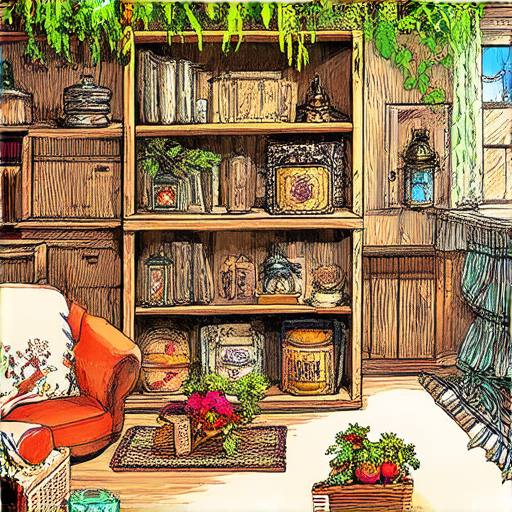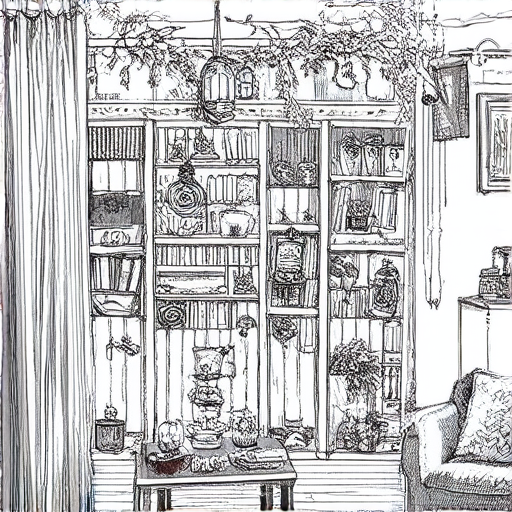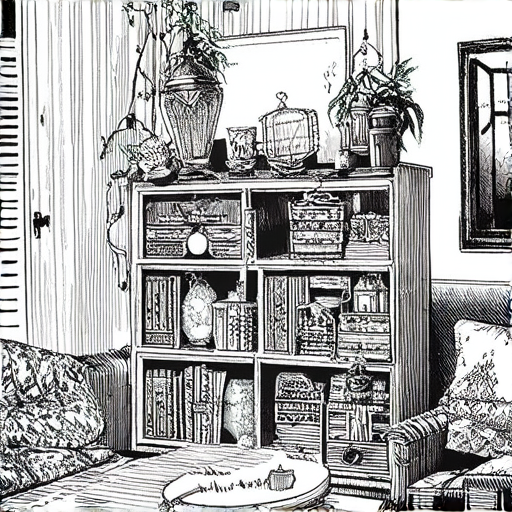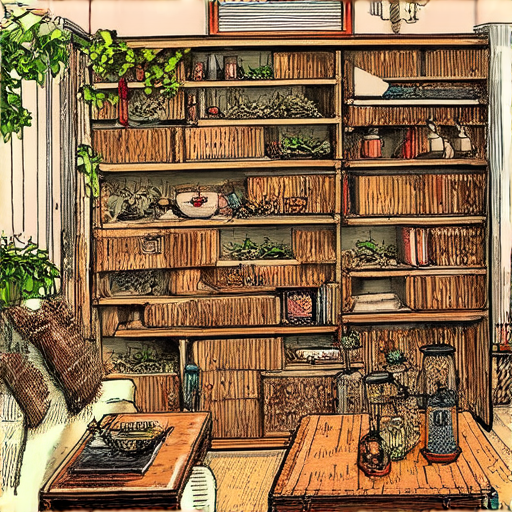When it comes to elevating your home decor, there’s often a fine line between functionality and aesthetics. This is particularly true when it comes to shelving, which serves both purposes by providing storage space while also adding visual interest to a room. However, traditional bookshelves and bookcases can sometimes feel bland and uninteresting, failing to add the personality and style that homeowners crave.

Make Your Shelves More Interesting
We’ve got some fantastic ideas to take your shelving game to the next level.
-
Add Decorative Accents
You don’t have to break the bank to give your shelves a stylish makeover. Add decorative accents like vases, sculptures, or picture frames to create visual interest. Consider mixing and matching different textures, shapes, and sizes to keep things visually appealing.
-
Incorporate Greenery
Bring the outdoors in by adding some lush greenery to your shelves. Choose plants with varying heights and textures to create a visually appealing display. Don’t forget to add some decorative planters to complement your green friends.
-
Utilize Lighting
Lighting can completely transform the ambiance of a room. Use string lights, fairy lights, or table lamps to create a warm and inviting glow on your shelves. This will not only add visual interest but also create a cozy atmosphere.
-
Showcase Personal Items
Your shelves are the perfect place to showcase personal items that reflect your personality and style. Display family photos, heirlooms, or collectibles to add a touch of warmth and character to your space.
-
Get Creative with Storage
Ditch boring storage solutions and get creative with unique containers and baskets. Use woven baskets, vintage suitcases, or wooden crates to store books, linens, or other household items. This will not only add visual interest but also keep your belongings organized.
-
Mix and Match Styles
Don’t be afraid to mix and match different styles and materials on your shelves. Combine modern and traditional pieces, or pair glass and wood to create a unique and eclectic look. This will add visual interest and prevent your shelves from looking too uniform.
-
Add Texture and Pattern
Texture and pattern can add depth and visual interest to your shelves. Mix and match different textures like wood, metal, and glass, and incorporate patterns through throw pillows, blankets, or rugs. This will create a visually appealing display that’s sure to catch the eye.
-
Display Artwork
Your shelves are the perfect place to showcase your favorite artwork or prints. Hang framed pieces, display canvas art, or use a gallery wall to create a stunning visual display. This will add a touch of sophistication and culture to your space.
-
Keep it Minimal
Sometimes less is more. Keep your shelves clutter-free and minimalist by displaying only a few select items. This will create a clean and sleek look that’s perfect for modern homes.
Is it Cheaper to Build a Shelf or Buy One?
The age-old debate continues – is it cheaper to build a shelf or buy one? As a homeowner, you want to save money without sacrificing quality and functionality.
- Building a Shelf: With the rising cost of lumber, you might think building a shelf is out of the question. However, with some basic tools and materials, you can create a sturdy and stylish shelf that fits your needs.
- Buying a Shelf: On the other hand, purchasing a pre-made shelf can be convenient, but it often comes with a hefty price tag. Plus, you may have limited options when it comes to customization and style.
Cost Comparison:
- Lumber Costs: A 2×4 board costs around $3-$5 per linear foot, depending on the type and quality. For a standard shelf, you’ll need 2-3 boards, which translates to $6-$15.
- Tools and Materials: Basic tools like a saw, drill, and screws will set you back around $50-$100. Additional materials like wood glue, nails, and sandpaper will add another $20-$50 to the total.
- Total Cost: Assuming a simple shelf design, the total cost of building a shelf would be around $76-$165.
- Purchasing a Shelf: Pre-made shelves can range from $50-$500 or more, depending on the size, material, and brand.
Conclusion:
While building a shelf requires some effort and investment, it can be significantly cheaper than buying a pre-made one. By choosing the right materials and designing a simple yet functional shelf, you can save money and still achieve the look and feel you desire.
Tips for Building a Shelf:
- Use reclaimed or recycled materials to reduce waste and costs.
- Opt for affordable alternatives like MDF or plywood.
- Keep your design simple to minimize material usage.
- Consider repurposing old furniture or pallets for a unique and eco-friendly option.

Decorating Shelves Like a Pro
We’ve got the scoop on how to decorate shelves like a pro, and it’s easier than you think.
- Vary Shelf Contents
- No Need to Center Items
- Mix Heights and Textures
- Play with Patterns and Colors
- Add Greenery
- Group Similar Items Together
- Leave Space Between Items
For a visually appealing display, mix and match items on each shelf. If your top shelf has three decorative pieces, try placing only two items on the next shelf down. This creates a balanced look and prevents the space from feeling cluttered.
You don’t have to center every item on each shelf. Leave some room for a few statement pieces – 1 to 3 items per shelf – to draw attention to specific features.
To add visual interest, combine items of varying heights and textures. Group similar items together, then intersperse them with taller or shorter pieces to create a dynamic display.
Don’t be afraid to incorporate patterns and colors into your shelf decor. Mix and match different hues, textures, and patterns to create a unique and eye-catching display.
Incorporating plants or greenery into your shelf decor can bring life and freshness to the space. Choose low-maintenance options like succulents or air plants for easy care.
Grouping similar items, such as books or decorative objects, creates a cohesive look and makes the space feel more organized.
Don’t overcrowd your shelves. Leave some space between items to create a clean and airy feel. This also makes it easier to dust and maintain the space.
By following these simple tips, you’ll be well on your way to creating beautifully decorated shelves that showcase your personal style.
Additional Tips:
- Experiment with Different Arrangements
- Keep it Simple
- Have Fun!
Try out different arrangements until you find one that feels just right. Don’t be afraid to move things around and experiment with new combinations.
Avoid over-accessorizing your shelves. Keep the focus on a few statement pieces and let the rest of the space breathe.
Decorating your shelves should be enjoyable! Experiment with different styles and themes until you find one that reflects your personality.

Alternatives to Wood for Shelves
We understand that you may want to explore options beyond traditional wood for building shelves.
- MDF (Medium-Density Fiberboard): A cost-effective alternative to wood, MDF is made from wood fibers and resin, offering a smooth surface and consistent texture.
- Plastic: Plastic shelves are durable, water-resistant, and easy to clean, making them ideal for bathrooms, kitchens, and laundry rooms.
- Metal: Metal shelves offer a modern look and are often used in industrial-style decor. They come in various finishes, from sleek chrome to rustic metal.
- Glass: Glass shelves add a touch of elegance to any room, reflecting light and creating a sense of openness.
- Bamboo: Bamboo is a sustainable, eco-friendly option that offers a unique texture and appearance.
- PVC (Polyvinyl Chloride): PVC shelves are lightweight, waterproof, and resistant to warping, making them suitable for outdoor use.
- Copper: Copper shelves bring a luxurious feel to any space, with a warm, rich color that develops a beautiful patina over time.
- Reclaimed Wood Alternatives: Consider using reclaimed wood alternatives like recycled pallet wood, old doors, or salvaged fencing to add character to your shelves.
When choosing an alternative to wood, consider factors like durability, maintenance, and style to ensure your shelves meet your needs and complement your home decor.
Hardware and Fasteners
The type of hardware and fasteners you use will depend on the material you’ve chosen for your shelves. Here are some general guidelines:
- MDF and plywood require screws or nails specifically designed for these materials.
- Plastic and PVC shelves usually need plastic or metal fasteners.
- Metal shelves often require metal screws or bolts.
- Glass shelves typically need specialized glass clips or adhesive.
- Bamboo and reclaimed wood alternatives may require wooden or bamboo-specific fasteners.
Tips for Building Shelves
To ensure your shelves are sturdy and secure, follow these tips:
- Measure carefully to avoid errors during construction.
- Choose the right type of hardware and fasteners for your material.
- Use level tools to ensure your shelves are perfectly horizontal.
- Test the weight capacity of your shelves before loading them with heavy items.
What is the Material That Looks Like Wood But Isn’t?
We’ve got you covered if you’re searching for alternatives to real wood flooring that still offer the aesthetic appeal of traditional wood.
- Laminate Flooring: Laminate flooring has come a long way in recent years, offering a realistic wood look that’s often difficult to distinguish from the real thing. It’s easy to install, durable, and resistant to scratches and dents.
: Engineered wood flooring is made by layering wood fibers in different directions, making it less prone to shrinking and expanding than solid hardwood. It’s a cost-effective option that still offers the beauty of real wood. : Bamboo is a highly renewable resource that’s becoming increasingly popular as a sustainable alternative to traditional wood flooring. It’s lightweight, durable, and resistant to moisture damage. : Vinyl flooring has undergone significant improvements in recent years, offering a range of styles and designs that mimic the look of real wood. It’s waterproof, easy to clean, and resistant to scratches and dents. : Reclaimed wood flooring is made from salvaged wood materials, such as old barns or factories. It adds a unique touch to any room and can be a cost-effective option compared to traditional hardwood.
When choosing a material that looks like wood but isn’t, consider factors such as durability, maintenance requirements, and budget. Each option has its pros and cons, so take the time to research and compare before making a decision.
Why Choose Alternatives to Real Wood Flooring?
There are several reasons why you might choose alternatives to real wood flooring:
Conclusion
In conclusion, there are many materials that look like wood but aren’t. From laminate and engineered wood to bamboo and vinyl, each option has its unique benefits and drawbacks. By considering factors such as durability, maintenance requirements, and budget, you can find the perfect alternative to real wood flooring for your needs.

Choosing the Best Material for Shelves
We understand that selecting the ideal material for your shelves can be overwhelming, considering various factors such as durability, aesthetics, and budget.
- MDF (Medium-Density Fiberboard): A cost-effective option, MDF is made from wood fibers and resin, offering excellent stability and resistance to warping.
- Plywood: Composed of layers of wood veneer, plywood is a popular choice due to its strength, affordability, and versatility.
- Cherry Wood: Known for its rich, reddish-brown color and fine grain, cherry wood is a premium option that exudes elegance and sophistication.
- Oak Wood: With its distinctive grain pattern and robust texture, oak wood is a timeless favorite among homeowners seeking a classic look.
- Reclaimed Wood: Adding a touch of rustic charm, reclaimed wood is an eco-friendly option that repurposes salvaged materials, reducing waste and promoting sustainability.
When deciding between these options, consider factors such as your personal style, available budget, and intended usage of the shelves.
- Determine your budget**: Set a realistic price range to narrow down your choices and ensure you find a material that fits within your means.
- Assess your lifestyle**: Think about how often you’ll use the shelves and whether they’ll be exposed to heavy loads or harsh environmental conditions.
- Consider your design preferences**: Choose a material that complements your home’s aesthetic and reflects your personal taste.
- Evaluate durability and maintenance**: Select a material that requires minimal upkeep and can withstand regular wear and tear.
By weighing these factors and exploring the characteristics of each material, you’ll be well-equipped to make an informed decision and choose the perfect shelves for your unique needs.

0 Comments